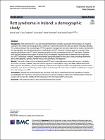| dc.contributor.author | Tropea, Daniela | |
| dc.date.accessioned | 2024-04-12T10:53:59Z | |
| dc.date.available | 2024-04-12T10:53:59Z | |
| dc.date.issued | 2024 | |
| dc.date.submitted | 2024 | en |
| dc.identifier.citation | Zade K, Campbell C, Bach S, Fernandes H, Tropea D. Rett syndrome in Ireland: a demographic study. Orphanet Journal of rare diseases. 2024 Jan 31;19(1):34 | en |
| dc.identifier.other | Y | |
| dc.identifier.uri | http://hdl.handle.net/2262/108197 | |
| dc.description.abstract | Background: Rett syndrome (RTT) is a rare neurodevelopmental condition associated with mutations in the gene coding for the methyl-CpG-binding protein 2 (MECP2). It is primarily observed in girls and affects individuals globally. The understanding of the neurobiology of RTT and patient management has been improved by studies that describe the demographic and clinical presentation of individuals with RTT. However, in Ireland, there is a scarcity of data regarding individuals with RTT, which impedes the ability to fully characterize the Irish RTT population. Together with the Rett Syndrome Association of Ireland (RSAI), we prepared a questionnaire to determine the characteristics of RTT individuals in Ireland. Twenty-five families have participated in the study to date, providing information about demographics, genetics, familial history, clinical features, and regression.
Results: The results show that Irish individuals with RTT have comparable presentation with respect to individuals in other countries; however, they had a better response to anti-epileptic drugs, and fewer skeletal deformities were reported. Nonetheless, seizures, involuntary movements and regression were more frequently observed in Irish individuals. One of the main findings of this study is the limited genetic information available to individuals to support the clinical diagnosis of RTT.
Conclusions: Despite the limited sample size, this study is the first to characterize the RTT population in Ireland and highlights the importance of having a swift access to genetic testing to sharpen the characterization of the phenotype and increase the visibility of Irish individuals in the international RTT community. | en |
| dc.language.iso | en | en |
| dc.relation.ispartofseries | Orphanet Journal of rare diseases; | |
| dc.rights | Y | en |
| dc.subject | MECP2 gene; Neurodevelopmental disorder; Rett syndrome | en |
| dc.title | Rett syndrome in Ireland: a demographic study. | en |
| dc.type | Journal Article | en |
| dc.type.supercollection | scholarly_publications | en |
| dc.type.supercollection | refereed_publications | en |
| dc.identifier.peoplefinderurl | http://people.tcd.ie/tropead | |
| dc.identifier.rssinternalid | 265028 | |
| dc.identifier.doi | https://doi.org/10.1186/s13023-024-03046-8 | |
| dc.rights.ecaccessrights | openAccess | |
| dc.relation.doi | 10.1186/s13023-024-03046-8 | en |
| dc.relation.cites | Cites | en |
| dc.subject.TCDTheme | Inclusive Society | en |
| dc.subject.TCDTag | demographic of populations | en |
| dc.subject.TCDTag | rare diseases | en |
| dc.identifier.orcid_id | 0000-0001-9730-6636 | |
| dc.subject.darat_impairment | Epilepsy | en |
| dc.subject.darat_impairment | Intellectual Disability | en |
| dc.subject.darat_impairment | Physical disability | en |
| dc.subject.darat_thematic | Carers | en |
| dc.subject.darat_thematic | Children | en |
| dc.subject.darat_thematic | Health | en |
| dc.status.accessible | N | en |
| dc.contributor.sponsor | Irish Research Council (IRC) | en |
| dc.contributor.sponsorGrantNumber | NF2021 | en |




